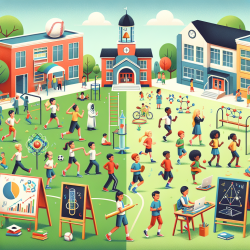Introduction
As practitioners in the field of speech-language pathology, we are continually seeking methods to enhance the academic and developmental outcomes for children. A recent study titled "Physical activity and academic achievement: an analysis of potential student- and school-level moderators" offers valuable insights into the relationship between physical activity and academic performance in school-aged children. This blog aims to translate the findings of this research into practical applications for educators and therapists working with children.
The Study at a Glance
The study conducted by Behringer et al. (2022) involved 4,936 Grade 4 students from 40 elementary schools in a diverse metropolitan area in Georgia. The researchers examined whether moderate-to-vigorous physical activity (MVPA) during school hours influenced academic achievement, and if this relationship was moderated by student-level characteristics (such as gender, race/ethnicity, and socioeconomic status) and school-level characteristics (such as the proportion of students qualifying for free/reduced-price lunch and the school's physical activity environment).
Key Findings
- Overall, the study found no significant moderation of the MVPA-academic achievement relationship by student- or school-level characteristics.
- Cross-sectional analyses indicated that Hispanic ethnicity moderated the relationship for Grade 4 fall spelling marks, but the practical significance was negligible.
- Longitudinal analyses revealed no significant moderation by any of the examined characteristics.
Implications for Practice
The findings suggest that while physical activity is beneficial for children's health, its impact on academic performance is not significantly influenced by demographic or school-level factors. This information is crucial for practitioners and educators who are tasked with designing interventions and policies aimed at improving both health and academic outcomes.
Here are some practical steps practitioners can take:
- Encourage Daily Physical Activity: Promote at least 60 minutes of MVPA daily, as recommended by the CDC, to support overall health and well-being.
- Integrate Physical Activity into the Curriculum: Develop classroom activities that incorporate movement, which can help maintain students' attention and engagement.
- Advocate for School Policies: Work with school administrators to ensure that physical education and recess are prioritized and not sacrificed for more academic instruction time.
Encouraging Further Research
While this study provides valuable insights, it also highlights the need for further research into the nuances of how physical activity impacts academic achievement. Future studies could explore different types of physical activities, varying intensities, and their direct effects on cognitive functions and learning processes.
Conclusion
The relationship between physical activity and academic achievement is complex and influenced by multiple factors. However, the current study suggests that promoting physical activity in schools can enhance students' health without compromising academic performance. As practitioners, we should continue to advocate for policies and practices that support physical activity as a vital component of children's daily routines.
To read the original research paper, please follow this link: Physical activity and academic achievement: an analysis of potential student- and school-level moderators.










